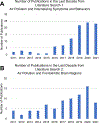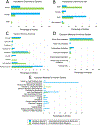Air pollution, depressive and anxiety disorders, and brain effects: A systematic review
- PMID: 36280190
- PMCID: PMC10015654
- DOI: 10.1016/j.neuro.2022.10.011
Air pollution, depressive and anxiety disorders, and brain effects: A systematic review
Abstract
Accumulating data suggest that air pollution increases the risk of internalizing psychopathology, including anxiety and depressive disorders. Moreover, the link between air pollution and poor mental health may relate to neurostructural and neurofunctional changes. We systematically reviewed the MEDLINE database in September 2021 for original articles reporting effects of air pollution on 1) internalizing symptoms and behaviors (anxiety or depression) and 2) frontolimbic brain regions (i.e., hippocampus, amygdala, prefrontal cortex). One hundred and eleven articles on mental health (76% human, 24% animals) and 92 on brain structure and function (11% human, 86% animals) were identified. For literature search 1, the most common pollutants examined were PM2.5 (64.9%), NO2 (37.8%), and PM10 (33.3%). For literature search 2, the most common pollutants examined were PM2.5 (32.6%), O3 (26.1%) and Diesel Exhaust Particles (DEP) (26.1%). The majority of studies (73%) reported higher internalizing symptoms and behaviors with higher air pollution exposure. Air pollution was consistently associated (95% of articles reported significant findings) with neurostructural and neurofunctional effects (e.g., increased inflammation and oxidative stress, changes to neurotransmitters and neuromodulators and their metabolites) within multiple brain regions (24% of articles), or within the hippocampus (66%), PFC (7%), and amygdala (1%). For both literature searches, the most studied exposure time frames were adulthood (48% and 59% for literature searches 1 and 2, respectively) and the prenatal period (26% and 27% for literature searches 1 and 2, respectively). Forty-three percent and 29% of studies assessed more than one exposure window in literature search 1 and 2, respectively. The extant literature suggests that air pollution is associated with increased depressive and anxiety symptoms and behaviors, and alterations in brain regions implicated in risk of psychopathology. However, there are several gaps in the literature, including: limited studies examining the neural consequences of air pollution in humans. Further, a comprehensive developmental approach is needed to examine windows of susceptibility to exposure and track the emergence of psychopathology following air pollution exposure.
Keywords: Air pollution; Anxiety; Brain; Depression; Frontolimbic; Mental health.
Copyright © 2022 Elsevier B.V. All rights reserved.
Conflict of interest statement
Declaration of Competing Interest The authors declare that they have no known competing financial interests or personal relationships that could have appeared to influence the work reported in this paper.
Figures





References
-
- Allaouat S, Yli-Tuomi T, Tiittanen P, Turunen AW, Siponen T, Kukkonen J, Kangas L, Kauhaniemi M, Aarnio M, Ngandu T, & Lanki T (2021). Long-term exposure to ambient fine particulate matter originating from traffic and residential wood combustion and the prevalence of depression. J Epidemiol Community Health, 75(11), 1111–1116. 10.1136/jech-2021-216772 - DOI - PMC - PubMed
-
- Ambient (Outdoor) Air Pollution Fact Sheet. (2021). https://www.who.int/news-room/fact-sheets/detail/ambient-(outdoor)-air-q...
-
- Andrade-Oliva MD, Aztatzi-Aguilar OG, Garcia-Sierra F, De Vizcaya-Ruiz A, & Arias-Montano JA (2018). Effect of in vivo exposure to ambient fine particles (PM2.5) on the density of dopamine D2-like receptors and dopamine-induced [(35)S]-GTPgammaS binding in rat prefrontal cortex and striatum membranes. Environ Toxicol Pharmacol, 60, 58–65. 10.1016/j.etap.2018.04.001 - DOI - PubMed
Publication types
MeSH terms
Substances
Grants and funding
LinkOut - more resources
Full Text Sources
Medical
Miscellaneous

